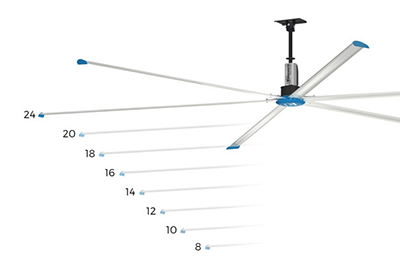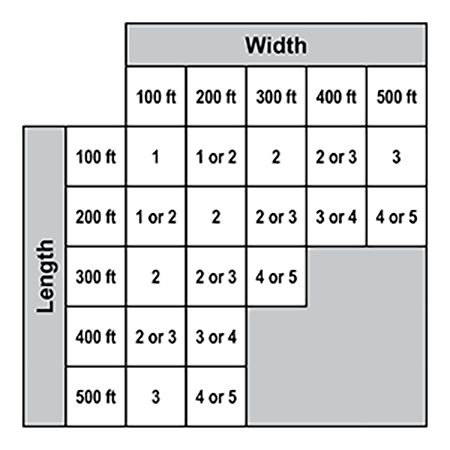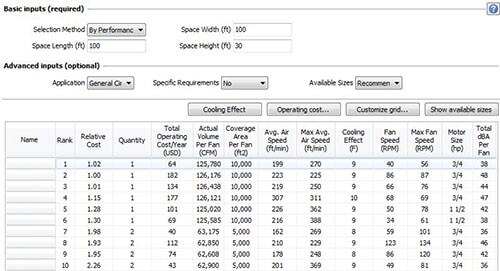
High volume, low speed (HVLS) fans are large diameter ceiling fans that circulate large volumes of air at low operational speeds. These fans are increasingly popular because of two main uses-- thermal comfort and energy efficiency.
Several companies currently manufacture HVLS fans, providing end-users plenty of choices when making selections. However, the number of fan products available also makes selecting the appropriate type and quantity a little challenging.
Luckily, there are resources available to help you feel confident in selecting an HVLS fan that meets your criteria for performance and budget. The following breaks down selection considerations and the two primary selection methods used.
Selection Considerations
Before making an HVLS fan selection, it is important to understand what requirements you need to satisfy with your design. There are a variety of factors to consider when determining your selection requirements. These factors range from fan aesthetics to physical clearance criteria and fan performance. Let’s look at each of these considerations in more detail.
Building type and intended use of the HVLS fans in the space are some of the first considerations that should be examined. For example, warehouse requirements are likely going to be different from an office lobby because of the size of the space, the type of work being done in the space, and aesthetic design criteria. Beyond these initial considerations, you need to understand how the HVLS fans will be used in the building. Will the fans provide thermal comfort in the summer or winter months only, or will the use be year-round? Geographic location can dictate some of these major considerations depending on when and how the seasons change.
Another key consideration is the fan’s intended mounting location. HVLS fans require the mounting location support its weight and the forces generated by the fan during operation. Attaching directly to the building structure is recommended while using the manufacturer’s recommendations. The fan location must be accessible to ensure ease of installation and routine maintenance. Adequate distance from walls, overhead doors, lighting, and sprinkler systems present potential clearance challenges to address prior to fan selection. Be sure to consult the manufacturer’s minimum clearance recommendations to ensure safe operation and correct performance from the fan.
Obstructions beneath the fan in the space can also affect airflow and overall performance. Therefore, it is important to consider how walls, furniture, equipment, pallet racking, cubicles, and other obstructions can influence performance to ensure that you have the appropriate size and quantity of fans laid out. For example, a wide-open area likely will require fewer fans because the air can travel across the floor and cover more area. Compare that to a space having many cubicle walls or racking. Such a space could disrupt airflow, leading to smaller fans or a larger quantity of fans to get proper coverage in the space.
Another key consideration in fan selection is confirming the HVLS fan delivers the required performance. The Air Movement and Control Association, International, Inc. (AMCA) is an independent third-party organization for the HVAC industry that verifies a manufacturer’s published performance information. Without certification from AMCA or other reliable industry organizations, there is no guarantee that the fan’s rated performance (airflow and efficiency) is accurate and meets customer requirements.
Two Selection Methods
After using the considerations mentioned to narrow down the list of available HVLS fan options (Figure 1), it’s time to make final fan selections. The industry currently uses two primary selection methods when determining the size and quantity of fans needed for a given space or application. HVLS manufacturers have used size-based selection since the development of HVLS fans and still commonly use it. However, a performance-based selection approach is gaining popularity as more manufacturers publish performance data.
 |
| Figure 1 – Shows commonly available HVLS fan sizes. Sizes represent fan diameter in feet. |
Size-Based Selection
Size-based selection identifies the quantity and size of fans able to fit in a building to provide adequate performance for a specific amount of floor area (Figure 2). It uses published cover area or fan spacing values to make a fan quantity determination. By utilizing simple data tables or rules of thumb for fan placement, the size-based method allows for fast and easy selection of HVLS fans without needing any specific information about the building or fan application.
 |
| Figure 2 – Example table of recommended fan quantity based on building dimensions. |
For this reason, a size-based selection is an approximation at best. It does not account for any application or performance considerations including, airflow, energy efficiency, sound, or air velocity requirements. Using a size-based selection method may result in an HVLS fan system that provides acceptable performance depending on your building needs. However, this method could just as easily result in a selection with more (or less) fans than actually needed for your building, causing higher first costs, dissatisfaction with fan performance or both.
Performance-Based Selection
The other commonly used HVLS fan selection method, known as performance-based selection, uses performance data and critical building criteria to make selections. Performance data provides a more accurate design that balances cost and performance. It uses criteria that include CFM, air velocity, sound, energy efficiency, weight, FRPM, RPM, and spacing (Figure 3). |
| Figure 3 – Shows the criteria used in performance-based selection. |
Performance-based selection uses data that complies with well-known industry standards (AMCA, ASHRAE) to ensure that the customer is getting a comfortable, energy-efficient (enforced by the Department of Energy, DOE) fan selection based on trusted information.
While far more accurate in providing the best design, the performance-based selection method is not widely used. The reason is that many HVLS manufacturers do not make their selection software publicly available to users. Many manufacturers have yet to publish performance data for their products, making a performance-based selection impossible. However, more manufacturers are beginning to make performance-based selection tools available, with some being easily accessible online.
Be Confident in Selecting the Best HVLS Fan(s)
Selecting the best HVLS fans for your application can be quite involved. Remember to factor in all the considerations that affect airflow and overall performance, then choose a selection method wisely. A size-based selection may be fast and easy but could result in an HVLS fan system that costs more and failing to meet desired performance requirements. Instead, utilize a performance-based selection process for greater confidence in your fan designs. This is the easiest ways to ensure comfortable air movement in your facility and satisfaction with your HVLS fan purchase.
Learn more about HVLS fan models that are available, then experience what a performance-based selection is by clicking on the destratification/comfort cooling image.
Overhead HVLS Fans


from